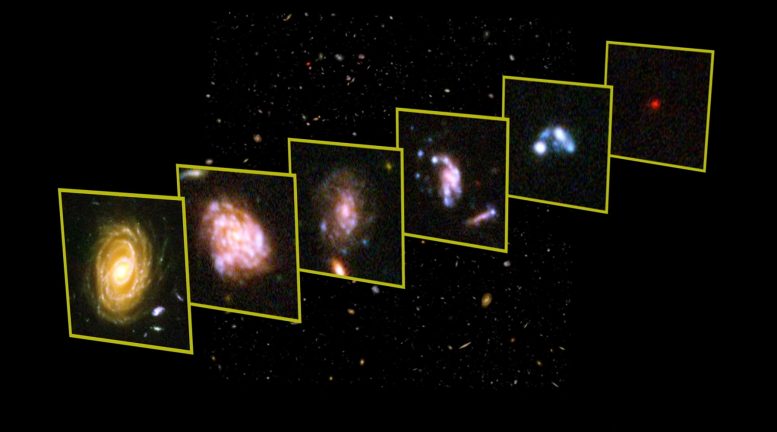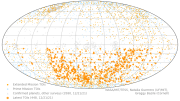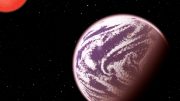
A deep field is a long exposure on a small field of view to observe the faintest objects possible. The Hubble Ultra Deep Field (UDF) represents the deepest visible-light observation of the universe. It provides a statistical sample of galaxies across the universe.
This six-minute visual exploration of the Hubble Ultra Deep Field showcases the characteristics and contents of this landmark observation, as well as its four-dimensional nature across both space and time. In particular, galaxies are seen to more than 12 billion light-years away / 12 billion years ago, allowing astronomers to trace the development of galaxies across cosmic time.
A deep field is a long exposure on a small field of view to observe the faintest objects possible. The Ultra Deep Field (UDF) represents the deepest visible-light observation of the universe (deeper views are extensions/subsets of this 2004 image). Containing about 10 thousand sources, the UDF provides a statistical sample of galaxies across the universe.
In this sequence, the 3D model of the UDF data set uses NASA and other images and source catalogs. More than 5,000 galaxies with cross-matched image cutout and distance measure are placed in their correct relative position throughout the long thin pyramid of the observation. To keep the fly-throughs succinct, the depth of the pyramid is shortened by a factor of a few hundred.
The visualization encompasses a suite of UDF science points in a single camera shot journey. Zooms, fades, fly-throughs, and overlay graphics visually express and highlight aspects such as the field of view, long exposure time, variety of galaxies, and extent across the observable universe. The critical idea that “looking farther out into space is also looking farther back in time” leads to examples, drawn directly from the data, of galaxy structure changing and growing over time.
The Ultra Deep Field, and other deep field studies, helps astronomers study the distribution, characteristics, and development of galaxies across space and time.
This presentation is based on work performed as part of the NASA’s Universe of Learning project and is supported by NASA under cooperative agreement award number NNX16AC65A. The NASA’s Universe of Learning (NASA’s UoL) project creates and delivers science-driven, audience-driven resources and experiences designed to engage and immerse learners of all ages and backgrounds in exploring the universe for themselves. The competitively-selected project represents a unique partnership between the Space Telescope Science Institute, Caltech/IPAC, NASA Jet Propulsion Laboratory, Center for Astrophysics | Harvard & Smithsonian, and Sonoma State University, and is part of the NASA Science Mission Directorate Science Activation program.









Um…..speechless.
Why does everything spin? Galaxies, black holes, whatever. Does anything not spin or orbit something else?
QUR’AN; surah Al-A’raaf “The Heights” verse 88
{In The Name of Allah The Compassionate The Merciful}
88) Do not they look in (the) dominion (of) the heavens and the earth and that which Allah has created, and that perhaps their end term has verily come near? Hence, in what statement after this will they believe.
QUR’AN; surah Al-Thariyaat “The Winds That Scatter” verse 47
{In The Name of Allah The Compassionate The Merciful}
47) And the heaven We constructed with strength, and indeed, *We are the expanders thereof.
*We here is used in the majestic sense. The meaning here is [I am]
And for the atheists’ assertion that no God created the universe, then the next question would be whose been holding the solar system in perfect synchrony down to split seconds without deteriorations or collisions for billions of years? Some may answer “nature”. Wouldn’t that be replacing one concept of God with another? And doesn’t nature simply refer to an expected outcome based upon what we’ve become used to as normal everyday occurrences, something natural? Is it “natural” that several spheres gloating in a vacuum revolve and rotate about one another in perfect timing without external intervention? Can we reproduce this phenomenon with even two magnetic spheres let alone dozens when considering moons? If the the universe is an “acceident” billions of flaming spheres, shouldn’t it be possible to recreate just one of these “accidents”. Did someone say it shouldn’t be described as a accident? If not, then it was all created. LOGIC!
3¼mips…eggnchips®€cu™
https://youtu.be/zsjTpFR0oYQ
THERE ARE NO WORDS BEYOND EMMENSITY,FULL OF …MORE THAN CAN BE EVER IMAGINED.
Yeah in that same coran it says men can beat up their wife and have sex with little girls
There is no mention of wife beating in the Quran. That is the work of their patriarchal culture of oppressing women. Just like with Christianity, the words have been distorted by people who like to subjugate and control.
Absolutely beautiful beyond anything we can imagine, but God has created all of this so we can enjoy the beauty of the universe and hopefully one day explore and find our extraterrestrial brethren.
Yes- scientists can suspend shperes in untouched constant distance from each other using ultra cold magnetism. Planets are magnetic- empty space is ultra cold- all I’m saying.